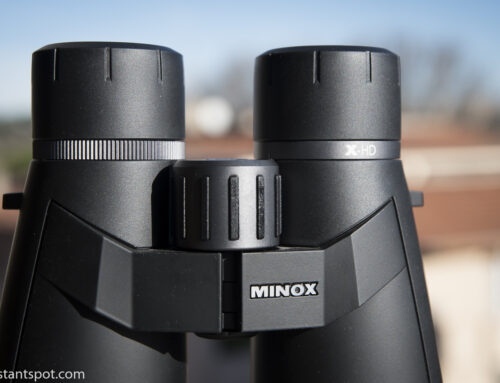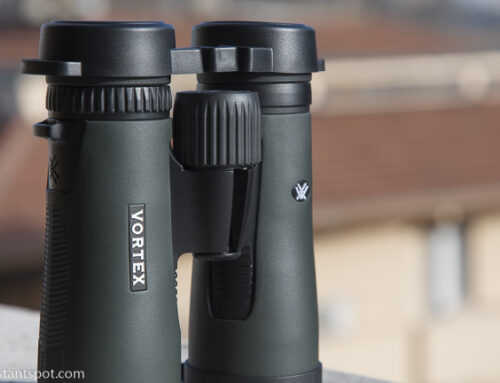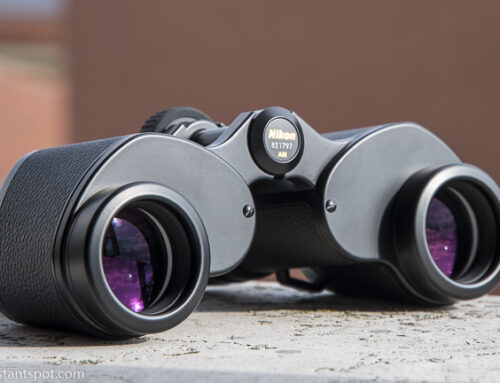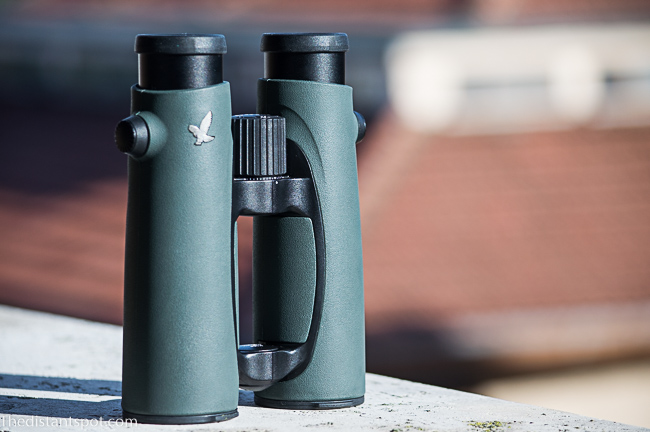Swarovski EL 8.5×42 W B
Intro
Exactly four years ago, in January 2017, I thought that the only way to stop craving for better binoculars was to buy those that, at the time, were considered the best. Obviously I was wrong, because the desire to try new equip remained intact, but I certainly did not regret the choice.
In my reviews I have used the Swarovski EL 8.5×42 W B many times as a term of comparison: the time has finally come to review them.
They are some of the best, most expensive and most popular binoculars in the world, even if they are not Swarovski’s top of the line anymore. A few months ago their place was taken by the NL Pure models, which cost even more but promise even higher performance, particularly considering the field of view.
Despite the introduction of the new models, the Swarovski EL 8.5×42 W B have not been abandoned: they have undergone a price reduction, but they are still in the catalog and this means that this could be a great time to buy them.
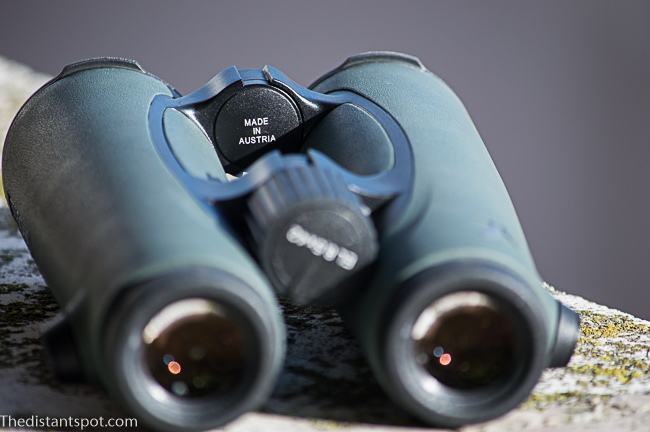 Construction
Construction
The few weaknesses of the Swarovski EL 8.5×42 W B are mostly found in their construction.
First of all they are bulky binoculars. I’m not saying they can’t be used comfortably, but they are a lot bigger than, for example, my Olympus EXWP I 10×42.
Optical quality is achieved with more complex optical schemes, that usually require a greater number of lenses, so this is an almost inevitable problem for top of the range models.
In this case, however, as unfortunately happens quite often, the carrying case does not help, but rather make the binoculars even more voluminous.
Depending on the use you want to make of them, this may be a relevant circumstance or not, but it is still good to keep it in mind.
During my mountain hikes, as well as travelling, I always carry a pair of binoculars in case there is something that deserves careful observation.
The Swarovski EL 8.5×42 W B, however, take up most of the backpack, forcing me to choose between them or a sweatshirt: the consequence is that most of the time I end up keeping the sweatshirt and choosing smaller binoculars.
And paraphrasing what they say about cameras: “the best binoculars are those you have with you”.
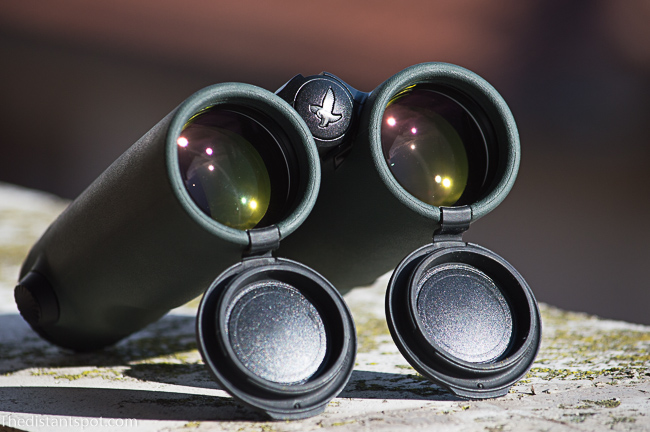
Furthermore, in a truly unjustifiable way for a product in this price range, the case – already quite bulky – is the same of the larger model. Therefore the overall dimensions are that of some (large) 50 mm binoculars.
I really don’t understand how it is possible that 200€ binoculars have dedicated cases while 2000€ binoculars do not.
Of course, there are other types of uses where space is not essential, such as static observations (including astronomical ones), or those in which you are sure you need binoculars and prefer to bring the most performing ones (even if the sweatshirt is always a strong option!).
The following photos have the purpose to highlight the difference in size between the Olympus EXWP I 10×42 and the Swarovski EL 8.5×42 W B, with and without case.
In fact, although the latter is quite larger than the former, the difference only becomes noticeable when the carrying cases are taken into account.
During transport, the Swarovski EL 8.5×42 W B almost take twice the volume of the Olympus EXWP I 10×42. This is the main reason why, on a couple of occasions, I preferred to travel with the Olympus rather than the Swarovski (the other reason concerns my understandable anxiety at the idea of traveling with 2000€ binoculars).
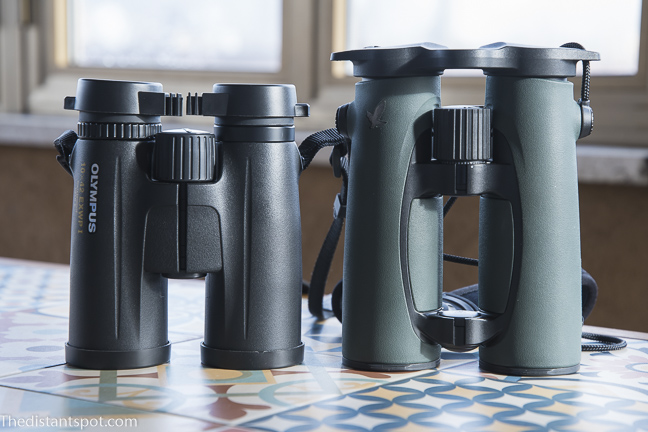
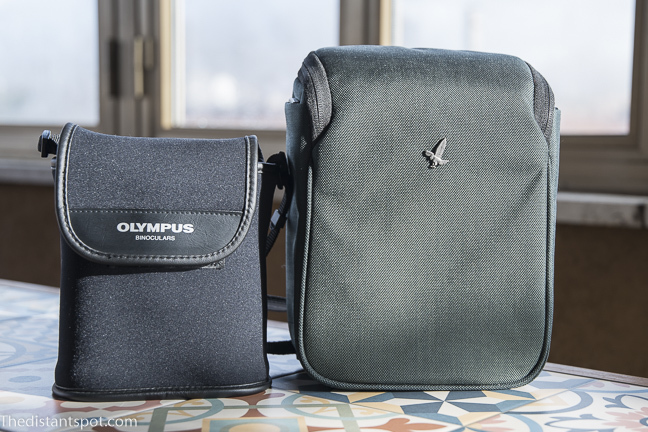
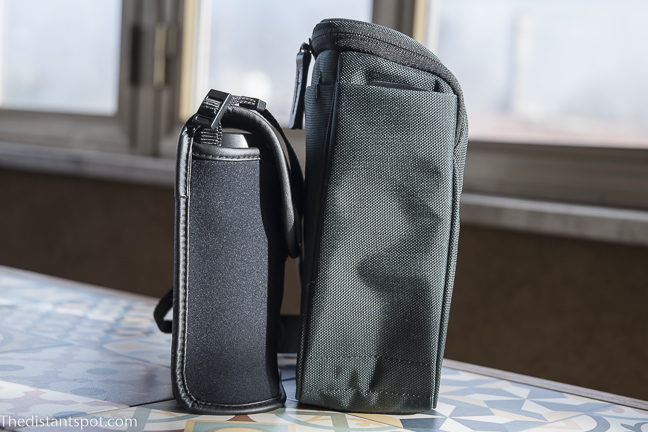
The body of the Swarovski EL 8.5×42 W B is rubberized with a perfectly adherent coating, in a beautiful green color and very easy to grip. The eyepiece caps are elegantly attached directly to the optical tubes, but being made of a single piece of rubber, I suspect they are bound to break where the rubber bends. This is an aspect that I highlighted in my review of the Steiner Nighthunter 8×56 which I think adopted an optimal solution.
Also, since the caps fit very tightly, and you have to pull them off the thin rubber edge to remove them, every time I use the binoculars I expect to tear them. Judging from the photos, it seems that the same system is also used for the new NL Pure models.
The focus ring is very simple and plasticky and, in my humble opinion, opposes too little resistance during rotation.
On the other hand, I like the solution used for the shoulder strap: the choice of fixing it on rotating pins prevents it from twisting and is very practical. The shoulder strap itself is covered in rubber and padded so as to be extremely comfortable.
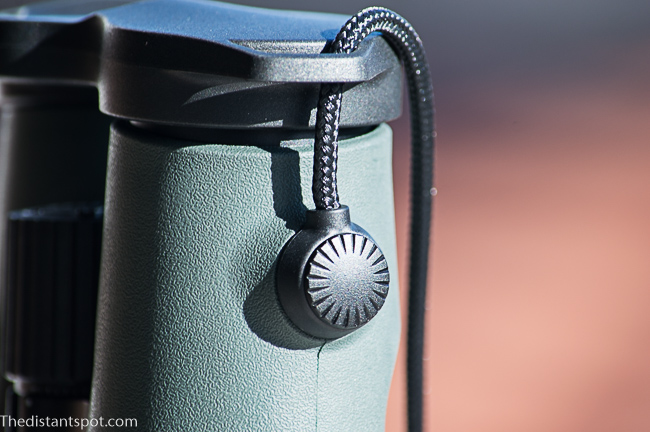 Optical qualities
Optical qualities
Immense. My criticisms mostly concern the construction and the portability of the binoculars, because from an optical standpoint they really have it all. On the other hand, they are also very expensive, confirming that extreme quality is not for free. And yet, every time I pick them up for a comparison with some other binoculars which “seem almost as good as the Swarovski”, I always discover that I was utterly wrong. I would really like to be able to test them against some other top of the range models.
Chromatic aberration
I think that chromatic aberration is the main optical defect of the Swarovski EL 8.5×42 W B.
It is moderately visible as soon as you move away from the center of the image, although it never becomes too pronounced.
The Kowa BD 8×32 Prominar XD is slightly better, which is incredible when you consider the price difference.
At night, bringing a light to the edge of the image, there is an evident violet outline, but nothing really annoying.
Sharpness
The field of view of the Swarovski EL 8.5×42 W B (which is very large!) is smooth and the image is perfectly sharp almost to the edge. There is a minimal field curvature at the very end, but any detail that is in focus in the center of the field will be almost perfectly in focus even at the edge. During the day, this perfect sharpness is pleasant but may not seem essential, but at night, in astronomical use, it is an added value that makes observation simply wonderful. It is easy to lose track of time while observing the Milky Way with the Swarovski EL 8.5×42 W B. Large formations, such as Hyades, are visible in their entirety and no deformation or aberration distracts the attention from the scene.
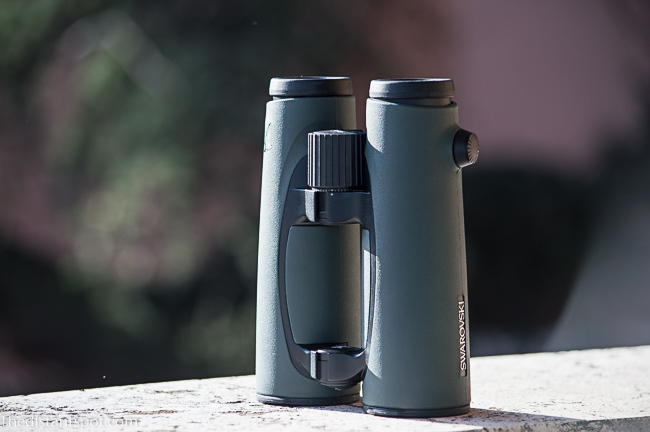 Astigmatism
Astigmatism
The stars are almost perfectly pinpoint and in any case I have never seen better results yet.
Coma
Coma becomes apparent from the middle of the field of view but is present to a minimum extent and the situation doesn’t really worsen moving towards the edge. Immediately after the chromatic aberration, this is one of the most obvious defects of the Swarovski EL 8.5×42 W B, but we are still talking about minor issues that do not compromise the observation in any significant way.
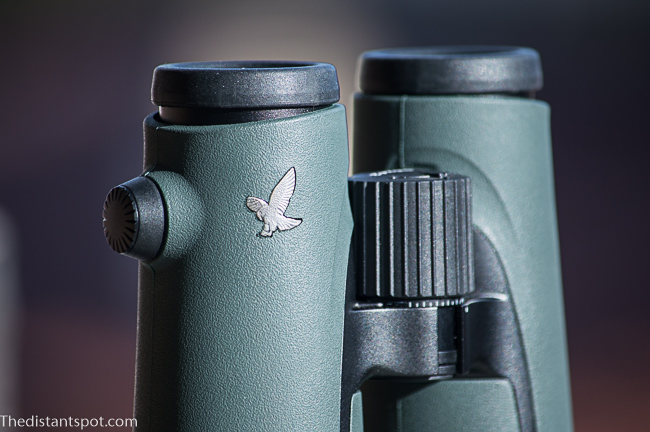 Tint
Tint
The image appears essentially neutral, the colors are saturated and the stars stand out properly. Mars also appears a convincing red.
Reflections and stray light
The excellent treatment of the prisms means that framing a street lamp just about ten meters away does not produce any noticeable spikes, unlike what normally happens with other roof prism binoculars. By moving the lamp to one side of the image, reflections form on the opposite side, very visible although not too annoying. However, that is an extreme and mostly theorical test, because I cannot think of valid reasons to frame a light source so close and powerful at night.
If the street lamp is just outside the field of view, it brightens the opposite side of the image. Apart from these circumstances, however, the Swarovski EL 8.5×42 W B do not exhibit particular problems with the lights either inside or outside the frame.
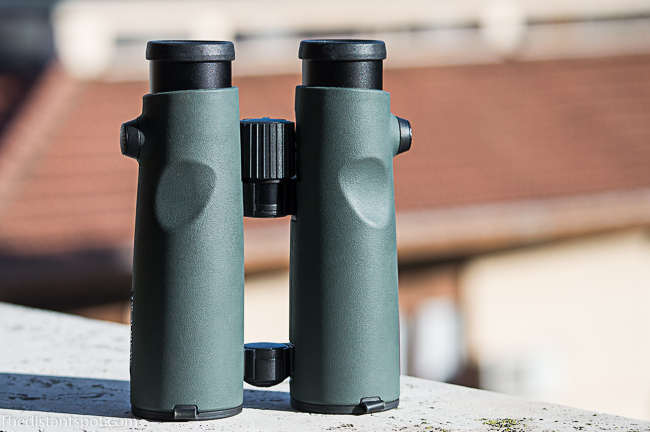 Distortion
Distortion
The distortion is almost completely corrected.
Conclusions
Even after the recent price reduction, the Swarovski EL 8.5×42 W B still cost almost two thousand euros.
It would be unreasonable to think that an (almost) top of the range model could have the same price/quality ratio as a mid-range product, since its aim is to offer the highest quality without worrying about the price.
And yet such a figure must be justified on the ground if you think about what you can get with 400 euro binoculars.
In my opinion, the Swarovski EL 8.5×42 W B pass the exam. They are incredible binoculars, almost perfectly corrected, and that explains why they are among the most desired and celebrated binoculars in the world. They have flaws, but none are really serious. Their construction (and that includes the carrying case), although very good in an absolute sense, does not match their optical quality and that constitutes the area with the widest room for improvement, but that does not change the overall judgment which still remains excellent.
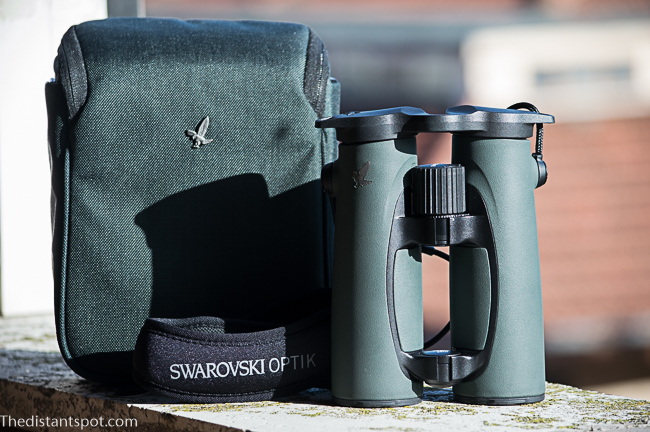
Swarovski EL 8.5×42 W B
Intro
Exactly four years ago, in January 2017, I thought that the only way to stop craving for better binoculars was to buy those that, at the time, were considered the best. Obviously I was wrong, because the desire to try new equip remained intact, but I certainly did not regret the choice.
In my reviews I have used the Swarovski EL 8.5×42 W B many times as a term of comparison: the time has finally come to review them.
They are some of the best, most expensive and most popular binoculars in the world, even if they are not Swarovski’s top of the line anymore. A few months ago their place was taken by the NL Pure models, which cost even more but promise even higher performance, particularly considering the field of view.
Despite the introduction of the new models, the Swarovski EL 8.5×42 W B have not been abandoned: they have undergone a price reduction, but they are still in the catalog and this means that this could be a great time to buy them.
 Construction
Construction
The few weaknesses of the Swarovski EL 8.5×42 W B are mostly found in their construction.
First of all they are bulky binoculars. I’m not saying they can’t be used comfortably, but they are a lot bigger than, for example, my Olympus EXWP I 10×42.
Optical quality is achieved with more complex optical schemes, that usually require a greater number of lenses, so this is an almost inevitable problem for top of the range models.
In this case, however, as unfortunately happens quite often, the carrying case does not help, but rather make the binoculars even more voluminous.
Depending on the use you want to make of them, this may be a relevant circumstance or not, but it is still good to keep it in mind.
During my mountain hikes, as well as travelling, I always carry a pair of binoculars in case there is something that deserves careful observation.
The Swarovski EL 8.5×42 W B, however, take up most of the backpack, forcing me to choose between them or a sweatshirt: the consequence is that most of the time I end up keeping the sweatshirt and choosing smaller binoculars.
And paraphrasing what they say about cameras: “the best binoculars are those you have with you”.

Furthermore, in a truly unjustifiable way for a product in this price range, the case – already quite bulky – is the same of the larger model. Therefore the overall dimensions are that of some (large) 50 mm binoculars.
I really don’t understand how it is possible that 200€ binoculars have dedicated cases while 2000€ binoculars do not.
Of course, there are other types of uses where space is not essential, such as static observations (including astronomical ones), or those in which you are sure you need binoculars and prefer to bring the most performing ones (even if the sweatshirt is always a strong option!).
The following photos have the purpose to highlight the difference in size between the Olympus EXWP I 10×42 and the Swarovski EL 8.5×42 W B, with and without case.
In fact, although the latter is quite larger than the former, the difference only becomes noticeable when the carrying cases are taken into account.
During transport, the Swarovski EL 8.5×42 W B almost take twice the volume of the Olympus EXWP I 10×42. This is the main reason why, on a couple of occasions, I preferred to travel with the Olympus rather than the Swarovski (the other reason concerns my understandable anxiety at the idea of traveling with 2000€ binoculars).



The body of the Swarovski EL 8.5×42 W B is rubberized with a perfectly adherent coating, in a beautiful green color and very easy to grip. The eyepiece caps are elegantly attached directly to the optical tubes, but being made of a single piece of rubber, I suspect they are bound to break where the rubber bends. This is an aspect that I highlighted in my review of the Steiner Nighthunter 8×56 which I think adopted an optimal solution.
Also, since the caps fit very tightly, and you have to pull them off the thin rubber edge to remove them, every time I use the binoculars I expect to tear them. Judging from the photos, it seems that the same system is also used for the new NL Pure models.
The focus ring is very simple and plasticky and, in my humble opinion, opposes too little resistance during rotation.
On the other hand, I like the solution used for the shoulder strap: the choice of fixing it on rotating pins prevents it from twisting and is very practical. The shoulder strap itself is covered in rubber and padded so as to be extremely comfortable.
 Optical qualities
Optical qualities
Immense. My criticisms mostly concern the construction and the portability of the binoculars, because from an optical standpoint they really have it all. On the other hand, they are also very expensive, confirming that extreme quality is not for free. And yet, every time I pick them up for a comparison with some other binoculars which “seem almost as good as the Swarovski”, I always discover that I was utterly wrong. I would really like to be able to test them against some other top of the range models.
Chromatic aberration
I think that chromatic aberration is the main optical defect of the Swarovski EL 8.5×42 W B.
It is moderately visible as soon as you move away from the center of the image, although it never becomes too pronounced.
The Kowa BD 8×32 Prominar XD is slightly better, which is incredible when you consider the price difference.
At night, bringing a light to the edge of the image, there is an evident violet outline, but nothing really annoying.
Sharpness
The field of view of the Swarovski EL 8.5×42 W B (which is very large!) is smooth and the image is perfectly sharp almost to the edge. There is a minimal field curvature at the very end, but any detail that is in focus in the center of the field will be almost perfectly in focus even at the edge. During the day, this perfect sharpness is pleasant but may not seem essential, but at night, in astronomical use, it is an added value that makes observation simply wonderful. It is easy to lose track of time while observing the Milky Way with the Swarovski EL 8.5×42 W B. Large formations, such as Hyades, are visible in their entirety and no deformation or aberration distracts the attention from the scene.
 Astigmatism
Astigmatism
The stars are almost perfectly pinpoint and in any case I have never seen better results yet.
Coma
Coma becomes apparent from the middle of the field of view but is present to a minimum extent and the situation doesn’t really worsen moving towards the edge. Immediately after the chromatic aberration, this is one of the most obvious defects of the Swarovski EL 8.5×42 W B, but we are still talking about minor issues that do not compromise the observation in any significant way.
 Tint
Tint
The image appears essentially neutral, the colors are saturated and the stars stand out properly. Mars also appears a convincing red.
Reflections and stray light
The excellent treatment of the prisms means that framing a street lamp just about ten meters away does not produce any noticeable spikes, unlike what normally happens with other roof prism binoculars. By moving the lamp to one side of the image, reflections form on the opposite side, very visible although not too annoying. However, that is an extreme and mostly theorical test, because I cannot think of valid reasons to frame a light source so close and powerful at night.
If the street lamp is just outside the field of view, it brightens the opposite side of the image. Apart from these circumstances, however, the Swarovski EL 8.5×42 W B do not exhibit particular problems with the lights either inside or outside the frame.
 Distortion
Distortion
The distortion is almost completely corrected.
Conclusions
Even after the recent price reduction, the Swarovski EL 8.5×42 W B still cost almost two thousand euros.
It would be unreasonable to think that an (almost) top of the range model could have the same price/quality ratio as a mid-range product, since its aim is to offer the highest quality without worrying about the price.
And yet such a figure must be justified on the ground if you think about what you can get with 400 euro binoculars.
In my opinion, the Swarovski EL 8.5×42 W B pass the exam. They are incredible binoculars, almost perfectly corrected, and that explains why they are among the most desired and celebrated binoculars in the world. They have flaws, but none are really serious. Their construction (and that includes the carrying case), although very good in an absolute sense, does not match their optical quality and that constitutes the area with the widest room for improvement, but that does not change the overall judgment which still remains excellent.



